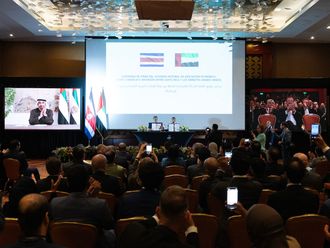Abu Dhabi: An Emirati engineering student has developed an artificial hand known as the Myoelectric Hand Prosthesis.
The prosthetic hand costs just Dh500 whereas a similar device would cost Dh30,000 in Europe.
Abdul Hafidh Al Zubaidi, who is in his twenties and set to complete his senior Bio-Medical Engineering project, was inspired to design a prosthetic hand after seeing some of his friends who lost their limbs in car accidents.
"The prosthetic hand I created is available in the UAE but it is mass produced in Europe, and commands a high price."
"The good thing about my robotic hand is that it is affordable. I would love to help many poor people out there who need a myoelectric arm. If I can manage mass production of these devices it would cost me less than Dh500 and I would not charge people more than that," said Al Zubaidi.
Electric sensors
The prosthetic hand allows amputees to have independent, easy, efficient and natural-like control of the artificial fingers. The myoelectric control detects signals from the muscle during contraction and is processed and analysed to be used as control signal for the prosthetic hand.
The control was fully developed in the lab of the Higher Colleges of Technology (HCT), Abu Dhabi Men's College by Al Zubaidi, under the supervision of Dr Michael Jacobson and David Kelly.
The project was selected for the Institute of the Electrical and Electronic Engineering competition.
The Biomedical Engineering programme involves the application of engineering in medicine and biology and is part of the Abu Dhabi Men's College curriculum. The project was sponsored by the Health Authority-Abu Dhabi (HAAD).
The prosthetic hand contains a grip function, which enables the amputee to hold and carry objects with the usage of myoelectricity which replaces mechanical controls.
"If someone lost their hand I can connect some electrodes to the remains of the muscles. My main goal in designing this project was to use myoelectric activity to control a hand grasp prosthesis by replacing the mechanical controls; the purpose was a simple-to-use, self-controlled hand; high speed response; increase patient versatility; natural like movement and an affordable end product," said the student.
Future plans
It took Al Zubaidi two semesters to complete his project.
He used transistors, integrated circuits, operational amplifiers, aluminium frame and silicon as materials for the hand.
He had several rounds of discussions with experts in the field, including neurologists, to understand how the human body works, and worked closely with engineers to assess technicalities involved in producing movement and hand grasp.
"I just wanted to have a clear picture. The college's equipment used in the manufacture was not cheap. However, the hand itself cost Dh500 only, including fingers and palm; the motor inside to control the fingers and logic control which is the most advanced part," said Al Zubaidi.
Al Zubaidi intends to continue his research next semester in a design class, where he will be adding sensors that connect to an end wire connected to the upper arm with live skin. This thermo sensor will give a small microelectric shock to the amputee to have a feel for temperature when grasping a hot or cold object.














